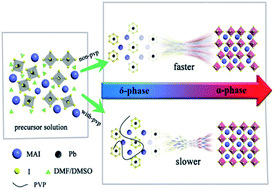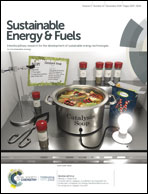Enhanced perovskite crystallization by the polyvinylpyrrolidone additive for high efficiency solar cells†
Abstract
Recently, perovskite solar cells (PSCs) have drawn a lot of attention due to their booming power conversion efficiency (PCE). However, the photovoltaic performance of PSCs is usually limited by the quality of the perovskite film. Here, trace polyvinylpyrrolidone (PVP) is introduced into the perovskite precursor solution as an additive for the crystalline defect passivation. The PVP with carbonyl delays the transition of the perovskite from the δ-phase to α-phase, which slows down the crystallization process. Thus, the crystallization rate of the α-phase perovskite can be controlled by forming coordination and a better film quality is achieved. As a result, we achieve a champion PCE of 19.63%, which is much higher than the 17.47% of the reference PSC. This study shows the mechanism of the material quality improvement by the additive during the perovskite film formation, where three processes are proposed to describe the film crystallization. We prove that the addition of PVP is an effective approach to improve the quality of the perovskite film, providing a valuable guidance for the development of high efficiency PSCs.



 Please wait while we load your content...
Please wait while we load your content...